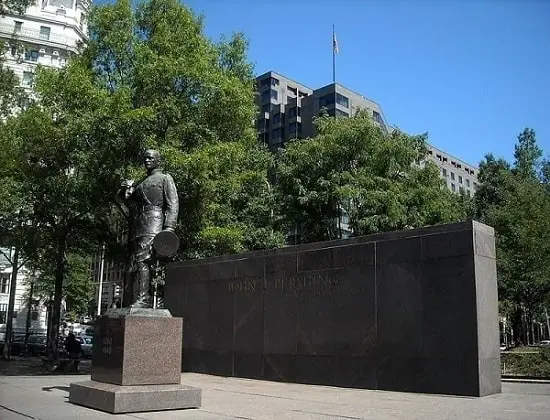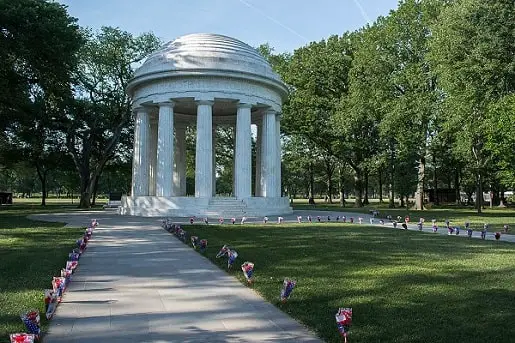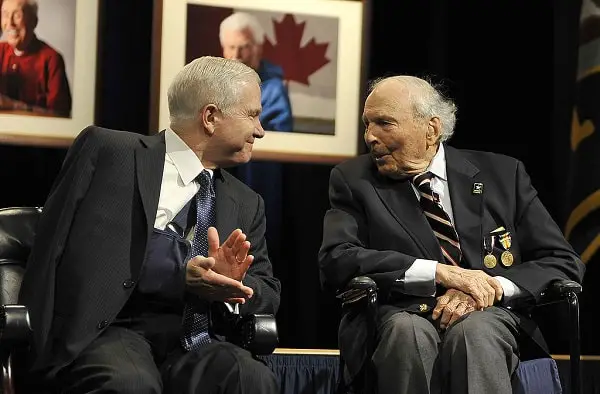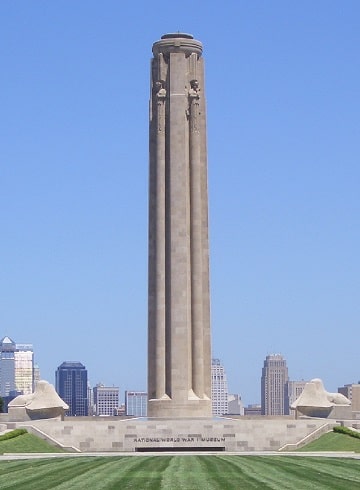The National World War 1 Memorial is situated at Pennsylvania Avenue and 14th Street in Washington D.C at Pershing Park. The construction was authorized by the National Defense Authorization Act of 2015 which was mandated by the WW1 Centennial Commission.
The memorial honors the service provided by the Amerian Armed forces during World War 1.
The Persing Park which was constructed in 1981 includes other prestigious memorials out of which the most honored is the memorial to Army General, John J. Pershing.
Likewise, a design presented by the team of Sabin Howard, Joseph Weishaar, GWWO architects, and Phoebe Lickwar, has been chosen as the winner, in 2016. The design is titled The weight of Sacrifice and by 2024 it will be completed and presented to the world.
On the 26th of April, 2021, U.S President Joe Biden announced to open the memorial for the public while the infantry regiment raised the flag.
Likewise, the District of Columbia War Memorial was also established on the National Mall in 1931. It memorialized District residents who fought in the United States armed services during World War 1.
Similarly, the Liberty Memorial, a 217-foot-tall tower with an artificial burning pyre atop it, was the tallest. It is located in Kansas City, Missouri.
Additionally, a Memorial Court surrounded the tower. It also had a Memory Hall on the east and a Museum Building on the west.
The museum building was dedicated to Kansas Citians who died in the war.
The memorial was dedicated on November 11, 1926, after construction workers broke ground on November 1, 1921.
Where is the World War 1 memorial situated?
Content
The World War 1 memorial is located in Washington, D.C., in Pershing Park. Kansas City also has a monument.
Who designed the National World War 1 memorial?
Harold Van Buren Magonigle designed the World War 1 memorial.
Besides the ones in Washington and Kansas City, how many World War 1 memorials are there in the U.S.?
There are 100 WW 1 Memorials scattered throughout the U.S. The Memorial Coliseum in L.A, Chicago’s Soldier Field, San Francisco’s War Memorial Veterans Building and Opera House, and Washington DC’s Pershing Park are all the official 100 “WW1 Centennial Memorials”.
The Location – Pershing Park

Various nineteenth-century structures occupied the Pershing Park site until around 1930. However, in 1930 the structures were ordered to be blocked and demolished as per the legal title enforced by the federal government.
And in 1957, the site was designated as Persing Square by the legislation and was passed by Congress.
The area’s development was contentious, as many parties proposed competing for tributes to the Army General, John J. Pershing.
As a result of these debates, inaction ensued and the area remained empty and frequently littered by the beginning of 1962.
However, the area did not remain the same for long. In 1963 ( September ), the area was planted with flowers and grass by the officials of the District of Columbia in order to make it more presentable.
Additionally, in November of the same year, the Council of Presidents submitted a plan to reconstruct Pennsylvania Avenue N.W. The plan was proposed to the U.S Capitol from the White House.
The plan also mentioned about the construction of the Western Plaza or the National Plaza, when approved, would require the demolishment of buildings including Pershing Square.
Some legions especially the Americans advocated constructing a magnificent Pershing statue at the square but were kept under hold until the finalization of the Pennsylvania Avenue plan.
This led to a permanent halt to the construction of the National Plaza. And, a modest Freedom Plaza that avoided the demolition of Pershing Park was constructed.
In the 1970s, the designs for a relatively bigger park with some monuments and a memorial to General Pershing were completed by the construction committee.
The construction work continued from 1970 until 1981, during which both Freedom Plaza and Pershing Park were built concurrently. And, Pershing Park officially opened its door to the public on the 14th of May, 1981 at 11:45 in the morning.
Now, the famous Pershing Park features a pond, a fountain, Robert White’s statue of Pershing, benches around the statue, memorial walls, and flowers.
Though the park now is under the management of the National Park Service, it is owned by the District of Columbia.
Design and Construction of the National World War 1 Museum

A pledge(S.Con.Res. 114) was presented by Senator Kit Bond in 2000 with the renovations of the Liberty Memorial.
He proposed granting the Memorial of Liberty full government accreditation as the National World War 1 Museum of America. However, the title was only an archaic term as it could not muster qualification.
In 2004, Karen McCarthy, a representative sponsored legislation, during which the National WW2 Memorial was yet to be opened in Washington D.C. The purpose was to designate the Memorial of Liberty as America’s National World War 1 Museum.
Jim Talent, a senator, sought consensus in the Senate to alter the proposal. However, on the 15th of June, 2004, the amendment was adopted unanimously leading to the passing of bills for both houses of Congress.
The legislation was signed into law by President of the United States, George W. Bush on the 28th of October, 2004.
Moreover, the successful attempt to create the National World War 2 Memorial sparked interest in a National World War 1 memorial.
After numerous failed attempts, legislators introduced legislation to build the National World War 2 Memorial in 1987, and on the 12th of May, 1993 pass Congress.
Likewise in 2000, Vietnam Veterans Memorial Fund’s CEO, Jan Scruggs, insisted on re-committing the renowned Memorial of the District of Columbia War to all the veterans of WW1.
Scruggs also mentioned that a Congress member was working toward achieving the change but not a single bill was submitted in any of the 3 subsequent Congresses.
Likewise, the legion of Americans campaigned to convert the memorial of the District of Columbia War in 2008.
Edwin Fountain, a local attorney, established the Memorial Foundation of WW1 to raise donations and boost the effort.
Jack Evans, a council member of D.C and D.C’s Congress Delegate – Eleanor Holmes Norton also became the organization’s trustee.
The Establishment of the World War 1 Centennial Commission

The government passed the legislation in the 112th Congress that compromised both sites as National World War 1 memorials. The decision was suggested by Edwin Fountain, an attorney with Senator Thune’s support.
On the 1st of February, 2011, John D. Rockefeller, a Senator established compromised legislation that would result in the establishment of the WW1 Centennial.
Additionally, it designated Kansas City’s Liberty Memorial and Washington D.C’s District of Columbia War Memorial.
A bill presented by Rockefeller also established the WW1 Memorial Foundation that would gather funds and look after the renovation of memorials in Washington D.C.
However, the residents of Columbia grew more hostile to the loss of their local memorial. Similarly, an organization working to preserve historic heritage lobbied for converting Pershing Park into memorials.
The WW1 Memorial Foundation also contended that Pershing Park’s location was extremely isolated due to the busy streets of D.C and resulted in lessening the significance of the war for being away from the National Mall.
Unfortunately, on the 27th of February, Frank Buckles died because of a natural cause that led to mass sorrow and initiation to have him aid to rest in the Capitol Rotunda of the United States.
Rep. Poe reintroduced the Frank Buckles WW1 Memorial Act on the 8th of March which matched Rockefeller’s bill. It also did the work of establishing a centennial commission and designating two memorials.
Additionally, like his 2009 law, Poe’s new effort empowered the WW1 Memorial Foundation toward soliciting funds. It also included designing and overseeing the memorial’s construction.
Poe’s bill has likely been forwarded to the House of the Committee of both – Government Reform and Natural resources.
The opposition to the D.C. War Memorial takeover was building.
On July 8, 2011, Del. Norton presented H.Res. 346. It is a non-binding resolution expressing the House of Representatives’ belief that the District of Columbia War Memorial should remain devoted entirely to District of Columbia residents.
Norton’s opinion shifted once she visited to see the memorial’s architecture as a diminution of the Columbia.
Kansas City’s National Museum and Memorial of World War 1

The Liberty Memorial was given to the National World War 1 Museum and Memorial in Kansas City, Missouri. It first opened in 1926.
The United States Congress appointed it as the country’s official World War 1 warred memorial and museum in 2004.
A non-profit corporation manages it in collaboration with the Kansas City Board of Parks and Recreation Commissioners.
The museum focuses on world events beginning with the causes of World War 1 before 1914. It also focuses on continuing through the 1918 armistice and 1919 Paris Peace Conference.
Visitors reach the 32,000-square-foot complex over a glass bridge above a field of 9,000 red poppies, each commemorating 1,000 warrior casualties.
Out of the two primary galleries with presentations of historical items, the first concentrates on the beginning of the Great Conflict before U.S. engagement.
Likewise, the second focuses on U.S. military and civilian involvement in the war and peace efforts.
In honor of troops and servicemen who fought and died in World War 1, a memorial tree dubbed “The Tree of Peace” was erected on the North Lawn.
Slovakia is officially represented via the international project “Tree of Peace” under the brand “Good Idea Slovakia—Ideas from Slovakia.”
The trademark authorization was given by the Slovak Republic’s Ministry of Foreign and European Affairs.
As such, the committee planted the memorial tree under the supervision of the Honorary Consulate of Slovakia in the United States. Slovak Republic’s Consulate General in New York City also supervised the tree plantation.
Conclusion
According to Vice Chairman of the Centennial Commission, Edwin L. Fountain, the goal was to create a memorial that would stand in solidarity with other monuments.
It develops World War 1 in the American consciousness while also acknowledging that, unlike those memorials, this had to be both a memorial and an urban park.
The $42 million project includes the park’s rehabilitation, which had fallen into disrepair. In addition, the design and installation of the memorial pieces also comprise the rehabilitation process.
The park also serves as a recreational amenity for both tourists and locals. What’s more, both memorials in Kansas City and Washington D.C. offer visitors intense and nostalgic memorabilia of the Great War.
